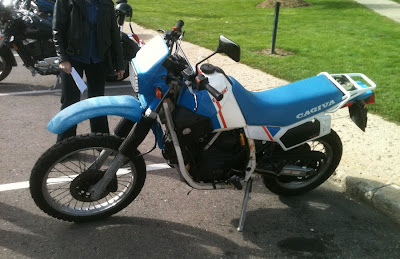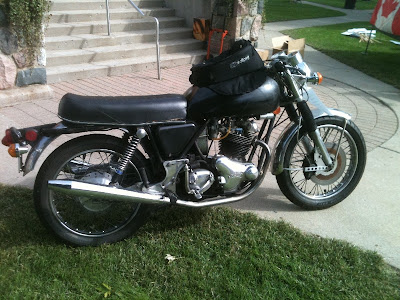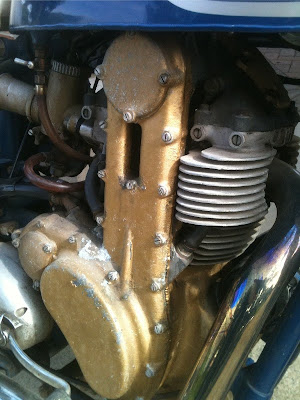Of course, I hadn't planned on this and all I had with me was the cell phone camera. Now I'm going to have to take back some of those terrible things I said about cell phone cameras.
At this time of day, there were mostly British bikes left, along with a few Japanese and assorted other makes. This post, I'll leave you with one Italian, one Indian/British, and a bunch of Brit bikes.

This Cagiva Elephant (pronounce 'Elle - font') is from the late 70's and was both sold as a commuter bike in Europe and, in racing form, as true dirt bike campaigned in the Paris-Dakar rally. This is a 650cc Elephant using a Ducati V twin engine. Not my choice of colors, but a serious bike in its time.
A modern Royal Enfield Bullet. It's a good thing that Triumph began to sell their retro line again, because Enfield is looking pretty good these days.

A well used modern Triumph Bonneville with a mild cafe' racer treatment. Note the turned down handlebars, clipped fenders, and racing number plate. This was no show bike, the dirt all came from hard road use. I saw the bike leave. A young guy with a cute girl on the back. Full throttle through the gears, of course.
That leads me to a philosophical question or two. Is the cafe' racer trend just another fad like choppers? Are young guys picking up the cafe' racer thing? It's clear they are mostly passing on Harley's, but could Harley catch the attention of the younger rider with a nicely done cafe' racer?

This Norton is from the time and a kindred spirit to the Bonneville cafe' racer. You could tell that this guy used his bike, a lot.

The well ridden Norton engine.

Speaking of Norton's, the 850 Commando is a pretty bike, especially all shiny like this one. I guess a cell phone camera can do alright in the right light.

Norton was an exotic fantasy bike when I was growing up. Before the Japanese bikes took over entirely, these were aggressive, fast, and manly.

One of the clubs that was still hanging out was the Matchless Club of America, Michigan branch. Matchless was a British motorcycle company from the 1899 to the early 60's. They were famous for their light, good handling chassis and their 500 cc single engines , including the single cylinder win at the first Isle of Man TT in 1907.

The red one is pretty much in "road" trim, with the addition of a racing number plate. The black one is a pure racer with a single seat and all the lights removed.
Matchless is known for it's hairpin valve spring which was used to reduce moving mass in the valvetrain. They later built hairpin spring engines that were used in Morgan three wheelers and Brough Superior motorcycles.

1958 Matchless G12 CS was a 650 cc parallel twin with slightly higher ground clearance for desert racing. This bike still used the Matchless twin. Later engines were the Norton 750 after Matchless fell apart financially and was acquired by Norton.

Matchless was owned by the same group that owned AJS, another light, fast British bike. Known as the Matchless "Cammy", the 350 OHC single is really an AJS engine from the 7R series.

Built from 1927 through 1954, this engine was very successful in racing for many years.

Another small volume British motorcycle maker with a great reputation is Velocette. Known for their high quality and innovation, Velocette was successful in racing from the 20's through the 50's. Their 350 cc won the world championships in '49' and '50'.

This beautiful Vellocette is an early 60's Velocette Venom 500 cc single. It has its cam high in the block so that the push rods could be short and light. This resulted in higher engine rpm and higher horsepower. A slightly modified version of this Venom set the record of 100 mph for 24 hours.
I am curious about the 2nd hand lever on the left side of the handlebar. My guess is a compression release for kick starting that big 500 cc single, but I am just guessing.


Pre-WW2 Vincent's were called Vincent HRD. This is a 1949 Comet 500 cc single that was apparently made just before the change in name. Racing versions of this bike won the Isle of Man TT. The name changed to just Vincent after WW2 when the company needed to sell bikes in the US and didn't want confusion between Harley (HD) and HRD. Nice versions like this are easily worth $50k these days.

Note the bronze or brass carburetor body. Not bad for a little show in a little farming town in Michigan. Also, the photo quality is a pleasant surpise for a little cell phone camera. Next year, I'll have to plan more carefully and bring a real camera.
Nice photos of great classic British bikes. The second photo is actually a late 60's Royal Enfield 750cc Interceptor twin, not a "modern Bullet" as suggested, great job none the less.
ReplyDelete